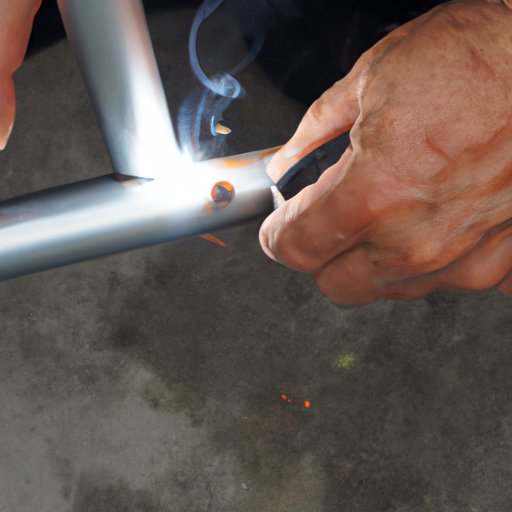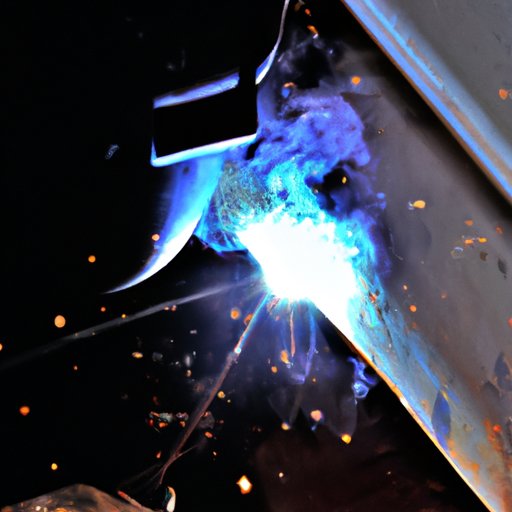
Introduction
Welding galvanized steel to regular steel can be a challenging process, but it is essential for many projects. If you’re considering welding these two metals together, it’s essential to understand the process, safety considerations, and potential challenges to achieve a successful outcome.
The Pros and Cons of Welding Galvanized Steel to Regular Steel
Welding galvanized steel to regular steel can offer several advantages, including increased corrosion resistance, greater durability, and an attractive finish. However, it can also present significant challenges, such as potential health hazards and technical difficulties.
One of the most significant benefits of welding galvanized steel to plain steel is the increased corrosion resistance. The addition of the zinc coating to the steel surface can make it more resistant to rust and other types of corrosion that can weaken the metal over time. Additionally, welding galvanized steel to regular steel can create a more durable result because the zinc coating can provide an additional layer of protection against scratches, scuffs, and other forms of damage.
Despite these benefits, there are several disadvantages to welding galvanized steel to regular steel. One of the most important is the potential health hazards associated with welding galvanized steel. Zinc is a metal that can vaporize at high temperatures during welding, producing fumes that can be toxic if inhaled. This presents respiratory hazards for welders, and the risk of metal fume fever, which is a condition that causes flu-like symptoms and can be serious if left untreated.
Another consideration when welding galvanized steel to regular steel is technical difficulties. The zinc coating can create porosity issues, which can lead to weld weaknesses and affect the quality of the weld. Additionally, welding can cause distortion of the metal, leading to misalignments and other issues if not carefully managed.
How to Safely Weld Galvanized Steel to Ordinary Steel
To achieve successful welds with galvanized steel and regular steel, it’s essential to follow some safety measures and proper techniques. Here’s a step-by-step guide to help you safely complete the welding process:
- Wear the proper welding protective gear, including gloves, a helmet, and a respirator, to safeguard yourself against the hazards of welding galvanized steel.
- Clean the galvanized steel thoroughly using a wire brush to remove all rust, oil, grease, and other contaminants.
- Prepare the steel to be welded, being sure to remove any scale or rust that may be present.
- Start welding, using either stick welding or MIG welding to bond the two metals together, taking care to avoid any porosity issues that may arise.
- Protect the weld from air and moisture to prevent rusting and other types of corrosion
When completing the welding process, it’s important to have the proper tools and equipment. Essential tools and equipment include wire brushes, clamps, pliers, welding guns, and welding machines that are specifically designed for welding galvanized steel. You may also need to have specialized filler materials that are compatible with the zinc coating.
Exploring the Challenges of Welding Galvanized Steel to Regular Steel
Welding galvanized steel to regular steel can present some challenges that need to be carefully managed to ensure the best possible outcome. These challenges include:
- Porosity issues that may arise due to the zinc coating, leading to weak welds or other quality problems.
- Possible distortion caused by welding, which can lead to misalignments and other issues if not managed correctly.
- The risk of toxic fumes, including the risk of zinc vapors that can cause respiratory problems and metal fume fever.
- The possibility of reduced weld quality and strength if the zinc coating is not removed correctly, leading to poor bonding between the two metals.
- The additional preparation time required to ensure that the metal surface is clean and free from rust, dirt, and other types of contamination.
To troubleshoot these welding difficulties, it’s important to be aware of proper welding techniques and to have the right tools and equipment at hand. You may need to experiment with different welding methods, adjust your settings, or use specialized compounds or materials to manage porosity and other issues that arise. By staying informed about the challenges associated with welding galvanized steel to regular steel, you can take steps to mitigate these challenges and increase your chances of success.

The Benefits and Drawbacks of Using Welding Material Specifically Designed for Galvanized Steel
If you’re looking for an easier solution to welding galvanized steel, you may consider using materials that are specifically designed for this purpose. These materials may offer some benefits, such as:
- Improved weld quality and reduced risk of porosity when compared to welding regular steel or galvanized steel with non-specific materials.
- Possibly improved bonding due to better compatibility with the zinc coating present on galvanized steel.
However, it’s important to note that there are also some drawbacks to using specific welding materials for galvanized steel. These drawbacks may include:
- Increased cost, as welding materials specifically designed for galvanized steel tend to be more expensive than non-specific materials.
- Reduced weld strength when compared to welding regular steel with nonspecific materials.
Examining the Potential Hazards of Welding Galvanized Steel to Plain Steel
Welding galvanized steel to regular steel can present several hazards that need to be carefully managed to ensure the safety of those involved. Some of the most significant hazards of welding galvanized steel to regular steel include:
- The risk of respiratory problems resulting from fumes produced during the welding process.
- The risk of metal fume fever, which can cause flu-like symptoms and can be serious if left untreated.
- The risk of burns and other types of injuries associated with welding, including electrocution and eye injuries.
To avoid these hazards, it’s essential to take the proper precautions when welding galvanized steel and regular steel together. One of the most important precautions is to ensure that you have the proper welding safety gear and equipment, including gloves, a helmet, and a respirator. It’s also essential to work in a well-ventilated area and to take breaks if you feel dizzy, nauseous, or otherwise unwell. It’s important always to follow safety guidelines and to stay up to date on the latest safety protocols and regulations regarding welding galvanized steel to regular steel.
Step-by-Step Guide to Using the Proper Technique for Welding Galvanized Steel to Steel
Proper technique is crucial when welding galvanized steel to regular steel to avoid potential hazards and ensure a successful outcome. Here’s a step-by-step guide to help you achieve the best possible outcome:
- Remove any contaminants, including rust, oil, and grease, from the galvanized steel.
- Prepare the steel for welding, removing any scale or rust that may be present.
- Preheat the steel to minimize any distortion that may occur during welding.
- Weld the steel together, taking care to avoid any porosity issues that may arise due to the zinc coating present on the galvanized steel.
- Post-weld cleanup requirements include removing any slag and cleaning any spatter that may appear post-welding.
It’s important to note that these steps are a general guide, and you will need to tailor your welding process to the specific materials and project at hand. By staying informed about welding techniques, you can better understand how to adjust your welding process to prevent distortion and optimize weld quality.
What You Need to Know Before Attempting to Weld Galvanized Steel to Standard Steel
Welding galvanized steel to regular steel is a complex process that requires careful attention to numerous factors, including safety, technique, and equipment. Before you attempt to weld galvanized steel to regular steel, be sure to consider these crucial points:
- To avoid health hazards, be sure to wear the proper welding safety gear, including gloves, a helmet, and a respirator.
- Clean the surfaces thoroughly to prevent any contamination from compromising the quality of the weld.
- Understand the risks associated with welding galvanized steel and take appropriate precautions to avoid them.
- Be prepared for challenges and setbacks that may arise during the welding process.
- Experiment with different techniques and materials and be sure to continue learning and improving with each project.
Conclusion
Welding galvanized steel to regular steel can be a challenging process, but it’s essential for many projects. By understanding the process, safety considerations, and potential challenges, you can improve your chances of achieving a successful outcome. Always be sure to take the proper precautions, follow good welding techniques and protocols, and stay informed about best practices for welding galvanized steel to regular steel.




